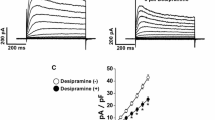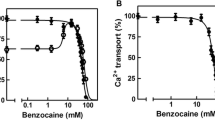Summary
In order to characterize the muscarinic binding site on coronary smooth muscle, we investigated the binding properties of (3H)quinuclidinyl benzilate (QNB) in membrane preparations of pig coronary arteries and atria. Scatchard analysis and Hill plot showed that (3H)QNB binds to a single population of sites in both tissues. The binding profiles of the muscarine receptor antagonists atropine, 11-((2-((dimethylamino)methyl)-1-piperidinyl)acetyl)-5,11-dihydro-6H-pyrido(2,3-b) (1,4)benzodiazepine-6-one (AF-DX 116), pirenzepine, and 4-diphenylacetoxy-Nmethylpiperidine methiobromide (4-DAMP) in both tissues were compared with binding data from other tissues, representative for different muscarinic binding site subtypes. It is concluded that the pig coronary smooth muscle muscarinic binding site is different from M1 and M2 binding sites investigated so far.
Similar content being viewed by others
References
Birdsall NJM, Burgen ASV, Hulme EC (1978) The binding of agonists to brain muscarinic receptors. Mol Pharmacol 14:723–736
Cheng YC, Prusoff WH (1973) Relationship between the inhibition constant (K i) and the concentration of inhibitor which causes 50 per cent inhibition (IC50) of an enzymatic reaction. Biochem Pharmacol 22:3099–3108
Costa LG, Murphy SD (1985) Characterization of muscarinic cholinergic receptors in the submandibular gland of the rat. J Autonom Nerv System 13:287–301
de Jonge A, Doods HN, Riesbos J, van Zwieten PA (1986) Heterogeneity of muscarinic binding sites in rat brain, submandibular gland and atrium. Br J Pharmacol 89:551P
Doods HN, Mathy MJ, Davidesko D, van Charldorp KJ, de Jonge A, van Zwieten PA (1987) Selectivity of muscarinic antagonists in radioligand and in vivo experiments for the putative M1, M2 and M3 receptors. J Pharmacol Exp Ther 242:257–262
Fields JZ, Roeske WR, Morkin E, Yamamura HI (1978) Cardiac muscarinic cholinergic receptors. Biochemical identification and characterization. J Biol Chem 253:3251–3258
Förstermann U, Müggge A, Frölich JC (1986) Endothelium-dependent relaxation of human epicardial coronary arteries: frequent lack of effect of acetylcholine. Eur J Pharmacol 128:277–281
Furchgott RF, Zawadzki JV (1980) The obligatory role of endothelial cells in the relaxation of arterial smooth muscle by acetylcholine. Nature (Lond) 288:373–376
Ganz P, Ludmer PL, Alexander RW, Shook TL, Wayne R, Mudge GH, Selwyn AP (1986) Impaired endothelium-dependent coronary dilation in patients with coronary artery disease. Blood Vessels 23:70
Ginsburg R, Bristow MR, Davis K, Dibiase A, Billingham ME (1984) Quantitative pharmacologic responses of normal and atherosclerotic isolated human epicardial coronary arteries. Circulation 69:430–440
Gräser T, Leisner H, Tiedt N (1986) Absence of role of endothelium in the response of isolated porcine coronary arteries to acetylcholine. Cardiovasc Res 20:299–302
Hammer R, Berrie CP, Birdsall NJM, Burgen ASV, Hulme EC (1980) Pirenzepine distinguishes between different subclasses of muscarinic receptors. Nature (Lond) 283:90–92
Hammer R, Giachetti A (1982) Muscarinic receptor subtypes: M1 and M2 biochemical and functional characterization. Life Sci 31:2991–2998
Hammer R, Giraldo E, Schiavi GB, Monferini E, Ladinsky H (1986) Binding profile of a novel cardioselective muscarine receptor antagonist, AF-DX 1I6, to membranes of peripheral tissues and brain in the rat. Life Sci 38:1653–1662
Hynes MR, Banner W, Yamamura HI, Duckles SP (1986) Characterization of muscarinic receptors of the rabbit ear artery smooth muscle and endothelium. J Pharmacol Exp Ther 238:100–105
Lowry OH, Rosebrough NJ, Farr AL, Randall RJ (1951) Protein measurement with the Folin phenol reagent. J Biol Chem 193:265–275
Michel AD, Whiting RL (1987) Direct binding studies on ileal and atria] muscarinic receptors. Br J Pharmacol (in press)
Scatchard G (1949) The attractions of proteins for small molecules and ions. Ann NY Acad Sci 51:660–672
Toda N (1983) Isolated human coronary arteries in response to vasoconstrictor substances. Am J Physiol 245:H937-H941
Watson M, Yamamura HI, Roeske WR (1983) A unique regulatory profile and regional distribution of (3H)pirenzepine binding in the rat provide evidence for distinct M1 and M2 muscarinic receptor subtypes. Life Sci 32:3001–3011
Watson M, Yamamura HI, Roeske WR (1986) (3H)Pirenzepine and (−)-(3H)quinuclidinyl benzilate binding to rat cerebral cortical and cardiac muscarinic cholinergic sites. Characterization and regulation of agonist binding to putative muscarinic subtypes. J Pharmacol Exp Ther 237:411–418
Van Charldorp KJ, de Jonge A, Davidesko D, Rinner I, Doods HN, van Zwieten PA (1987) Coronary constriction induced by vagal stimulation in the isolated rat heart. Eur J Pharmacol 136:135–136
Yamanaka K, Hashimoto S, Muramatsu I (1986) Species difference in the muscarinic receptors of thoracic aorta. J Exp Ther 237:980–986
Yasue H, Horio Y, Nakamura N, Fuji H, Imoto N, Sonoda R, Kugiyama K, Obata K, Morikami Y, Kimura T (1986) Induction of coronary artery spasm by acetylcholine in patients with variant angina: possible role of the parasympathetic nervous system in the pathogenesis of coronary artery spasm. Circulation 74:955–963
Author information
Authors and Affiliations
Additional information
Send offprint requests to I. Rinner
Rights and permissions
About this article
Cite this article
Rinner, I., Doods, H.N., van Charldorp, K.J. et al. Binding of muscarine receptor antagonists to pig coronary smooth muscle. Naunyn-Schmiedeberg's Arch Pharmacol 337, 146–150 (1988). https://doi.org/10.1007/BF00169241
Received:
Accepted:
Issue Date:
DOI: https://doi.org/10.1007/BF00169241




